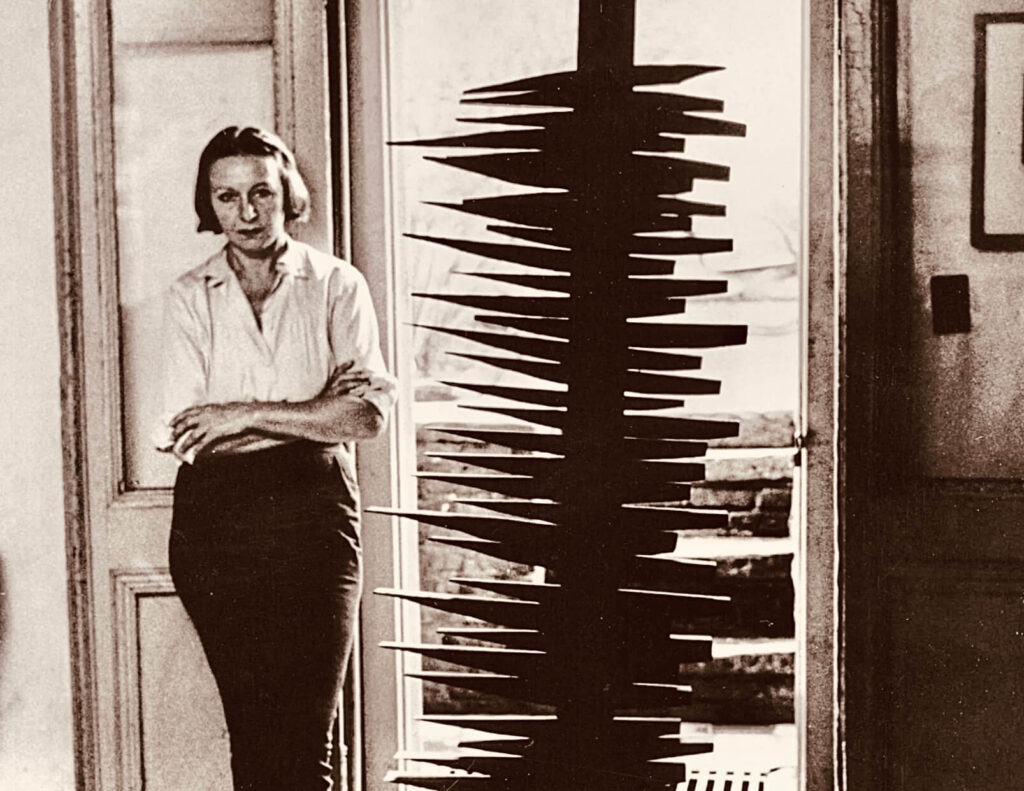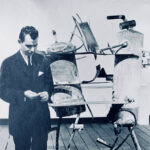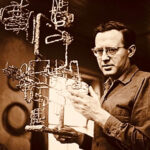Louise Nevelson
Louise Nevelson (1899-1988) was an American sculptor known for her monumental, monochromatic wooden wall pieces and outdoor sculptures. A pioneering figure in 20th-century art, Nevelson’s innovative use of discarded materials and her dramatic, often black, constructions earned her a prominent place in the history of modern sculpture. Her works, which blend elements of abstraction, surrealism, and cubism, explore themes of space, shadow, and form, challenging traditional notions of sculpture and redefining the possibilities of assemblage.

Early Life and Background
Louise Berliawsky was born on September 23, 1899, in Pereiaslav, Russia (now Ukraine). Her family emigrated to the United States in 1905, settling in Rockland, Maine. The transition to a new country and culture was challenging, and Nevelson’s early experiences of displacement and adaptation would later inform her artistic vision. From a young age, she demonstrated a keen interest in art, often using found objects to create her own imaginative worlds.
In 1920, Louise married Charles Nevelson, a wealthy shipping merchant, and moved to New York City. While her marriage provided financial stability, it was not creatively fulfilling. In 1929, Nevelson left her husband and embarked on a journey to pursue her artistic ambitions.
Education and Early Career
Nevelson’s formal art education began at the Art Students League of New York, where she studied with renowned artists such as Kenneth Hayes Miller and Hans Hofmann. Hofmann, in particular, influenced her approach to abstraction and composition. In the early 1930s, Nevelson traveled to Europe, where she was exposed to the works of Pablo Picasso, Henri Matisse, and the emerging surrealist movement. These experiences expanded her artistic horizons and deepened her commitment to exploring new forms and materials.
During the 1930s and 1940s, Nevelson experimented with various artistic styles and techniques. She created paintings, prints, and small sculptures, but it wasn’t until the 1950s that she found her true voice in assemblage. Influenced by the surrealist practice of using found objects, Nevelson began to collect discarded wood and other materials from the streets of New York City. She transformed these objects into intricate, large-scale sculptures that redefined the possibilities of assemblage art.
Breakthrough and Recognition
Nevelson’s breakthrough came in 1958 with her solo exhibition at the Grand Central Moderns Gallery in New York. The show, titled “Moon Garden + One,” featured her now-iconic monochromatic wooden wall sculptures. These works, composed of found wood pieces assembled into complex, interlocking structures, captivated the art world. Nevelson’s use of a single color, often black, white, or gold, created a sense of unity and depth, transforming everyday materials into monumental works of art.
Her work from this period, characterized by its architectural quality and dramatic use of shadow and light, challenged traditional notions of sculpture. Nevelson’s sculptures were not mere objects but environments that invited viewers to explore the interplay of form and space. Her innovative approach earned her critical acclaim and established her as a leading figure in the postwar art scene.
Important Artwork: “Sky Cathedral” (1958)
One of Louise Nevelson’s most significant and celebrated works is “Sky Cathedral” (1958). This monumental wall sculpture exemplifies her unique approach to assemblage and her ability to transform found materials into powerful, evocative works of art.
“Sky Cathedral” (1958)
“Sky Cathedral” is a large, monochromatic wooden assemblage measuring approximately 11 feet by 10 feet. The sculpture is composed of numerous wooden pieces, including boxes, moldings, spindles, and other found objects, meticulously arranged into a complex, interlocking structure. Painted entirely in black, the work creates a sense of depth and mystery, with light and shadow playing across its intricate surface.
The title “Sky Cathedral” suggests a spiritual or transcendent experience, and the work’s monumental scale and architectural quality reinforce this idea. The sculpture’s verticality and the upward movement of its forms evoke the soaring spaces of gothic cathedrals, while its dark, monochromatic palette adds a sense of solemnity and introspection.
“Sky Cathedral” is a testament to Nevelson’s ability to transform everyday materials into profound, poetic works of art. The sculpture’s intricate composition and dramatic use of shadow and light create a sense of depth and movement, inviting viewers to engage with it from multiple perspectives. The work’s abstract forms and architectural quality challenge traditional notions of sculpture, demonstrating Nevelson’s innovative approach to assemblage.
Mature Career and Continued Innovation
Throughout the 1960s and 1970s, Louise Nevelson continued to develop her distinctive style, creating increasingly ambitious and complex works. She experimented with new materials, including metal and plexiglass, and expanded the scale of her sculptures to include large outdoor installations. Her public works, such as “Atmosphere and Environment X” (1969) in Princeton, New Jersey, and “Sky Gate, New York” (1977) in Lower Manhattan, brought her vision of abstract, monumental sculpture to a broader audience.
Nevelson’s work from this period reflects her continued interest in exploring themes of space, light, and form. Her sculptures often featured a grid-like structure, with individual elements arranged in a way that suggested both order and chaos. This tension between structure and spontaneity is a hallmark of Nevelson’s mature style, demonstrating her ability to balance formal rigor with expressive freedom.
In addition to her work as a sculptor, Nevelson was also a dedicated teacher and mentor. She taught at several institutions, including the Pratt Institute and the Tamarind Lithography Workshop, where she inspired a new generation of artists with her innovative approach to materials and form.
Legacy and Impact
Louise Nevelson’s contributions to the field of sculpture were recognized with numerous awards and honors throughout her career. In 1962, she received the prestigious Logan Medal of the Arts, and in 1985, she was awarded the National Medal of Arts, the highest honor bestowed upon artists in the United States. Her work is included in the collections of major museums and galleries around the world, including the Museum of Modern Art, the Whitney Museum of American Art, and the Smithsonian American Art Museum.
Nevelson’s influence extends beyond her own body of work. As a pioneering female artist in a male-dominated field, she paved the way for future generations of women sculptors. Her commitment to exploring new forms and materials, combined with her innovative use of found objects, has inspired countless artists to push the boundaries of sculpture and assemblage.
Personal Life and Philosophy
Louise Nevelson’s personal life was marked by both triumphs and challenges. Her marriage to Charles Nevelson ended in divorce, and she faced significant financial struggles throughout much of her early career. Despite these difficulties, Nevelson remained committed to her artistic vision and continued to create powerful and innovative works.
Nevelson’s approach to art was characterized by a sense of curiosity and experimentation. She believed in the importance of pushing boundaries and exploring new possibilities, both in terms of materials and form. Her work reflects a deep engagement with the world around her, from the urban landscape of New York City to the broader cultural and artistic currents of her time.
Nevelson was known for her distinctive personal style, often dressing in dramatic, black clothing and wearing elaborate headpieces and jewelry. This sense of theatricality extended to her art, where she used shadow and light to create immersive, transformative experiences for viewers.
Conclusion
Louise Nevelson’s artistic journey is a testament to her resilience, creativity, and dedication to the practice of sculpture. Through her innovative use of materials and her exploration of form and space, Nevelson created a body of work that continues to resonate with viewers and artists alike. Her notable work, “Sky Cathedral,” exemplifies her ability to create dynamic and intellectually engaging compositions.
In celebrating Louise Nevelson’s life and work, we recognize her significant contributions to the development of abstract sculpture and her enduring legacy as a trailblazer in American art. Her sculptures remain powerful and evocative, reminding us of the potential of art to engage with the human condition and the world around us.



